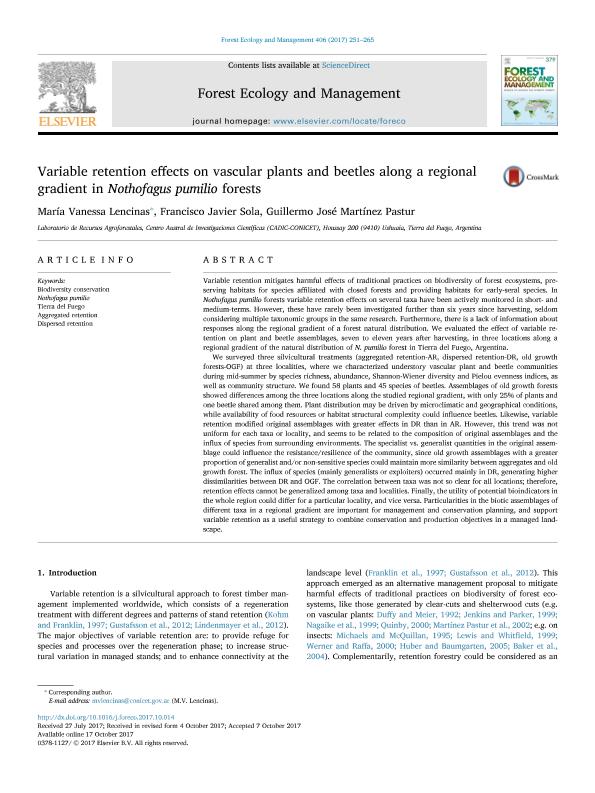Artículo
Variable retention effects on vascular plants and beetles along a regional gradient in Nothofagus pumilio forests
Fecha de publicación:
12/2017
Editorial:
Elsevier Science
Revista:
Forest Ecology and Management
ISSN:
0378-1127
Idioma:
Inglés
Tipo de recurso:
Artículo publicado
Clasificación temática:
Resumen
Variable retention mitigates harmful effects of traditional practices on biodiversity of forest ecosystems, preserving habitats for species affiliated with closed forests and providing habitats for early-seral species. In Nothofagus pumilio forests variable retention effects on several taxa have been actively monitored in short- and medium-terms. However, these have rarely been investigated further than six years since harvesting, seldom considering multiple taxonomic groups in the same research. Furthermore, there is a lack of information about responses along the regional gradient of a forest natural distribution. We evaluated the effect of variable retention on plant and beetle assemblages, seven to eleven years after harvesting, in three locations along a regional gradient of the natural distribution of N. pumilio forest in Tierra del Fuego, Argentina. We surveyed three silvicultural treatments (aggregated retention-AR, dispersed retention-DR, old growth forests-OGF) at three localities, where we characterized understory vascular plant and beetle communities during mid-summer by species richness, abundance, Shannon-Wiener diversity and Pielou evenness indices, as well as community structure. We found 58 plants and 45 species of beetles. Assemblages of old growth forests showed differences among the three locations along the studied regional gradient, with only 25% of plants and one beetle shared among them. Plant distribution may be driven by microclimatic and geographical conditions, while availability of food resources or habitat structural complexity could influence beetles. Likewise, variable retention modified original assemblages with greater effects in DR than in AR. However, this trend was not uniform for each taxa or locality, and seems to be related to the composition of original assemblages and the influx of species from surrounding environments. The specialist vs. generalist quantities in the original assemblage could influence the resistance/resilience of the community, since old growth assemblages with a greater proportion of generalist and/or non-sensitive species could maintain more similarity between aggregates and old growth forest. The influx of species (mainly generalists or exploiters) occurred mainly in DR, generating higher dissimilarities between DR and OGF. The correlation between taxa was not so clear for all locations; therefore, retention effects cannot be generalized among taxa and localities. Finally, the utility of potential bioindicators in the whole region could differ for a particular locality, and vice versa. Particularities in the biotic assemblages of different taxa in a regional gradient are important for management and conservation planning, and support variable retention as a useful strategy to combine conservation and production objectives in a managed landscape.
Archivos asociados
Licencia
Identificadores
Colecciones
Articulos(CADIC)
Articulos de CENTRO AUSTRAL DE INVESTIGACIONES CIENTIFICAS
Articulos de CENTRO AUSTRAL DE INVESTIGACIONES CIENTIFICAS
Citación
Lencinas, María Vanessa; Sola, Francisco Javier; Martínez Pastur, Guillermo José; Variable retention effects on vascular plants and beetles along a regional gradient in Nothofagus pumilio forests; Elsevier Science; Forest Ecology and Management; 406; 12-2017; 251-265
Compartir
Altmétricas




